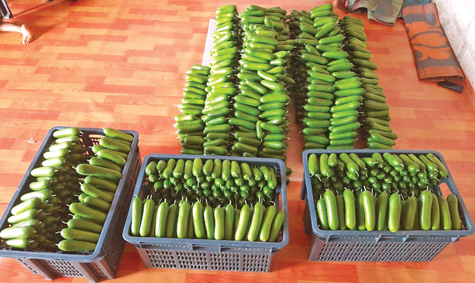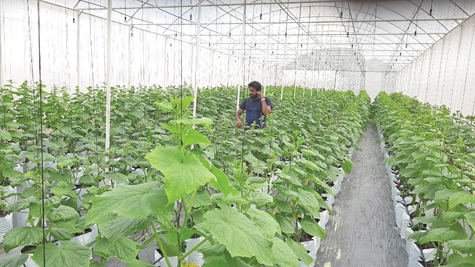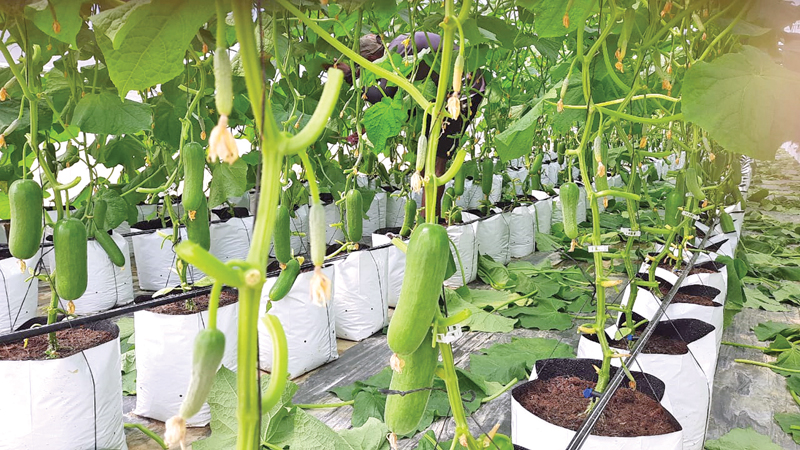 It seems the Opposition politicians are hard at work these days, trying to whip up a storm over ‘Mahaviru Naa’ celebrations in the North—much like the recent Bay of Bengal depression, which after wreaking havoc here, conveniently blew its cyclonic rage straight into Tamil Nadu.
It seems the Opposition politicians are hard at work these days, trying to whip up a storm over ‘Mahaviru Naa’ celebrations in the North—much like the recent Bay of Bengal depression, which after wreaking havoc here, conveniently blew its cyclonic rage straight into Tamil Nadu.
But. the deep depression having intensified into cyclone Fengal over the Bay of Bengal petered out rather predictably before slamming into Indian shores last Monday. As the Indian Meteorology Department had forecast, it faded into a modest low-pressure area over Northern Tamil Nadu—hardly the devastating ending some might have anticipated from a cyclone.

Prof. Abeysinghe
Lasantha Sandika
When a storm dumps enough rain to flood the country, you might think it would spark some collective empathy or at the very least, a serious conversation about disaster relief. But no—welcome to the South, where the political playbook dictates that the best response to agricultural devastation is a healthy dose of communal tension.
After all, what is a few thousand hectares of rice and vegetables and crop cultivations going under water when there is ‘tense’ issue such as the ‘Mahaviru Naal’ in the North to milk for political theatrics?
Simmer the communal hot pot
Never mind the farmers, whose cultivations, including 64,000 hectares of paddy in the Northern and Eastern Provinces alone now resembling lakes going underwater. Forget the fact that these regions bore the brunt of nature’s fury and that over two million farmers in the country depend on rice farming to keep their families fed and the country afloat. Who cares about livelihoods when you can simmer the communal hot pot to cause nationwide discontent?
And so, as the water recedes and farmers stare at their ruined fields, the political stage shifts to the tried-and-tested formula: whip up a little communal tension and fan the flames. You would have successfully diverted attention from an agricultural crisis to a convenient political spectacle. Or are we having a South-style master class in political misdirection?
So here we are, wading through the aftermath of a devastating flood, while the political scriptwriters dream up their next act.
The country has 2.3 million hectares of agricultural land, with 80 percent dedicated to non-plantation food crops such as rice, maize, vegetables, fruits and other crops, according to the Agriculture Department. The sector employs 28 percent of the country’s labour force, with small-scale farmers contributing the bulk of the agricultural output.

It’s too early to quantify the full extent of crop damage or the economic fallout from the floods, but assessments are underway, according to Dr. Chamila Chandrasiri, Director of the Socio-Economic and Planning Centre at the Agriculture Department. “Give us a week or two to get the assessments rolling,” she stated, noting that water must first recede from the flood-affected paddy fields and farmlands. Only then will agricultural officers be able to compile a complete report on the affected farmers, farmlands and crop losses.
Speculation, however, is rife. Critics argue that the National People’s Power Government may struggle to address the crisis, with murmurs of a looming food shortage due to flood-induced crop damage. Rumours also swirl about potential price spikes in rice, vegetables and fruit during the festive season and possibly well into next year. And if that’s not enough, a so-called ‘coconut mafia’ is reportedly emerging, threatening to hike prices alongside the notorious rice cartels.
While these projections aren’t entirely baseless, they remain speculative. The Government has ramped up support for farmers, providing access to fertiliser and better agricultural inputs. The Ministry of Agriculture, in collaboration with the Hector Kobbekaduwa Agrarian Research and Training Institute (HARTI) has also initiated long-term strategies to promote climate-smart agriculture and ensure food security and resilience.
HARTI Director and Chief Executive Officer, Prof. Abeysinghe Lasantha Sandika said they did not expect a flood-induced weather during this cultivation season. He said the relevant agenciesat no point of time forecast the kind of heavy rains that triggered floods. According to him the weather forecasters did not forecast the severity of the weather.
The recent floods across Sri Lanka have left paddy fields and farmlands submerged, causing significant damage to crops and irrigation systems. While the Meteorology Department issued a heavy rain warning on November 19, HARTI’s Prof. Sandika believes such forecasts need to be communicated at least a month in advance to allow farmers to adapt their sowing schedules.
Effort washed away
Farmers had sown seeds on November 15, just days before the rains struck. “The entire effort was washed away,” said Prof. Sandika. Now, farmers face the costly task of re-cultivating, with seed paddy and fertiliser costs doubling. This burden extends to the Government, which must support the recovery effort through subsidies and aid.

It is essential to study climate changes more closely and reassess when farmers should plant crops,
instead of strictly conforming to traditional farming schedules
Farmers now face the daunting task of restarting their cultivation processes and repeat the entire sowing procedure. This has effectively doubled their costs, creating additional financial strain not only to farmers but also for the Government, which has pledged to support recovery efforts.
Prof. Sandika highlighted that activating the Government’s fertiliser subsidy program was a key step to alleviate the burden. He assured that measures to restart cultivation are already in motion, with the subsidy program set to play a pivotal role.
Interestingly, the delayed activation of the subsidy program in certain areas has turned out to be a blessing in disguise. Since the initial crops in those regions were destroyed by floods, the program can now be implemented without the risk of losses on the prematurely ruined harvests. This timing allows the Government to focus its resources more effectively on supporting re-cultivation efforts.
Paddy cultivation in low-lying areas of the Northern and Eastern Provinces has been among the hardest hit by the recent floods. Extensive damage has also been reported to paddy and vegetable fields in districts such as Anuradhapura, Polonnaruwa, Ampara and Jaffna, while fruit and vegetable farming in the Nuwara Eliya and Badulla Districts has suffered significant setbacks.
The impact extends beyond farmers and their families, affecting urban populations, particularly in Colombo, who rely on rural agricultural produce. Vegetable prices have soared, forcing consumers in urban areas to pay significantly more for basic food items.
Nutrient-rich sediment
However, there is a silver lining amidst this crisis. According to Professor Sandika, receding flood waters often leave behind nutrient-rich sediment that can improve soil fertility. This natural enrichment can enhance soil productivity, though the benefits depend on factors such as the flood type, the affected region and the pre-existing soil condition.
These nutrients deposited by floodwaters have agricultural importance. For example Nitrogen, which is an organic matter from decaying, plants and sediment, is essential for plant growth. Nitrogen is a critical component of chlorophyll, which is vital for photosynthesis. Then Phosperous- which aids in root development and improves flowering and fruiting. Phosphorus is crucial for energy transfer within plants. Also Potassium, micronutrients such as Zinc, Iron, Magnesium and Calcium are also found in this fertile sediment.
They contribute to natural soil enrichment, and replenish nutrient-depleted lands, he said. This means once they re-start cultivation, there will be an increase in their crop yield. There will be marked improvement in food security.
The floods’ aftermath presents an opportunity for improved agricultural yields in the future, provided the recovery and replanting efforts are managed effectively. This underscores the need for comprehensive support systems and climate-adaptive agricultural strategies.
Prof. Sandika said as for crop damage, the Agriculture Department was working on it. Meanwhile, the Department of Irrigation has carried out a rough assessment indicating that the floods have significantly damaged irrigation infrastructure, with repairs potentially costing over Rs. 6,000 million.
In response to the immediate recovery needs of farmers, the Agriculture and Agrarian Insurance Board will provide compensation through its insurance schemes. Compensation will be available for six key crops – paddy, maize, potato, soybean, onion, and chilli – with a maximum payout of Rs 40,000 per acre. However, many farmers are unlikely to receive full compensation, since their crops were lost shortly after sowing, meaning they could receive less than Rs. 16,000 per acre, depending on their specific insurance agreements.
Prof. Sandika said that his personal view was that rice farmers should be compensated more and he is aware that the Government was taking steps to compensate vegetable farmers in the upcountry and the low country. Meanwhile, free seed paddy is to be distributed to farmers.
Flood risk
When asked about measures to mitigate future flood risks to paddy fields and farmlands, Prof. Sandika said the importance of developing a forewarning system was paramount. He said that even the monsoon patterns were shifting, making it crucial to adapt by adjusting the crop calendar to align with changing weather patterns.
“We cannot change Mother Nature, but we must learn to adapt to it,” he said. He also pointed out that it is essential to study climate changes more closely and reassess when farmers should plant crops, instead of strictly conforming to traditional farming schedules such as the Yala and Maha seasons. This approach would help farmers move away from outdated methods and embrace more flexible, climate-resilient practices.
To mitigate future climate risks, Prof. Sandika advocates the adoption of climate-smart agriculture, emphasizing the use of technology. While farmers traditionally rely on experience to determine planting schedules, he said that it’s time to shift to farming based on empirical evidence and research. This transition will allow farmers to make more informed decisions and better manage climate-related challenges.
He also highlighted the vulnerability of farmers cultivating crops on open land, which are more prone to weather extremes. To address this, Prof. Sandika suggests identifying entrepreneurs and guiding them towards protective agricultural practices. Many young farmers in the country are already using modern technology such as net houses and greenhouses to cultivate crops, to protect crops from adverse weather, pests and disease. Some of them have become successful exporters.
Net houses and greenhouse farming are forms of controlled-environment agriculture that optimise growth conditions, improve crop quality, and allow for off-season cultivation. These methods differ in design, materials, and functionality but share the goal of enhancing yields and providing a more resilient farming model in the face of climate change.
HARTI is leading a program to promote climate-smart agriculture by supporting young, entrepreneurial farmers. In collaboration with the Government, HARTI helps aspiring farmers’ access loan schemes of up to Rs. 3 million to start greenhouse farming. This initiative is supported by global partners, including the World Bank, which backs climate-protected agricultural practices.
Through specialised training programs, HARTI is guiding traditional farmers to embrace modern, resilient farming techniques. These efforts are intended to improve economic stability and the country’s food security. The training helps farmers transition from traditional methods to more sustainable, climate-smart practices.
The program is a key opportunity for young farmers to develop skills, boost welfare and contribute to the country’s agricultural and economic growth. By providing guidance, resources, and financial support, HARTI is helping create a new generation of agricultural entrepreneurs who can tackle climate challenges and enhance food production systems.




